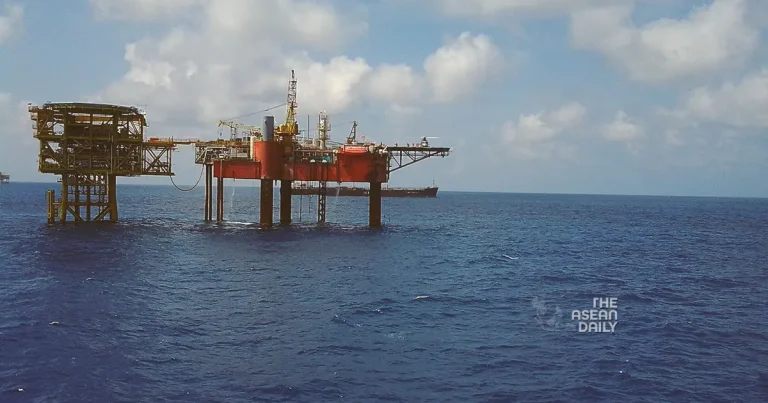3-12-2023 (JAKARTA) Once dominating the skyline in farmer Sukirman’s rice field, a towering oil rig has given way to a box-shaped metal cage, holding the remnants of a bygone era. Between 2018 and 2022, state-owned oil company Pertamina extracted hundreds of barrels daily from beneath this Subang village in West Java, casting bright lights into the night sky as volatile gases flared incessantly.
Fast forward to last year, and the rig stood abandoned. The oil had run dry, prompting Pertamina to shift its operations elsewhere in Subang. However, this deserted oil well may find a surprising resurgence if Indonesia succeeds in its ambitious plan to establish itself as the Asia Pacific hub for carbon capture and storage (CCS).
Indonesia envisages repurposing thousands of depleted oil and gas reservoirs across the nation to permanently sequester carbon dioxide emissions generated by heavy industries, both domestic and international. Major oil companies, including Exxon Mobil and Chevron, have expressed interest in this initiative, touting it as a dual-purpose strategy to reduce emissions and bolster economic growth.
During President Joko Widodo’s recent visit to Washington, Pertamina sealed agreements with Exxon Mobil and Chevron, setting the stage for a potential $2 billion investment in CCS facilities utilising two underground basins in the Java Sea. Furthermore, BP has embarked on a carbon capture, utilisation, and storage (CCUS) project off West Papua, with construction underway since November 24.
In a bid to foster collaboration, Indonesia has extended invitations to countries such as Japan, South Korea, and Singapore to participate in developing the necessary infrastructure for carbon storage within its borders.
Despite the optimistic outlook, analysts caution against CCS’s high costs, ranging from $80 to $1,000 per tonne of CO2 stored, coupled with its energy-intensive nature. Previous CCS projects have a track record of falling short on emissions reduction targets, with some abandoned midway through construction.
The Economic Equation
The concept of CCS technology dates back to the 1970s, originally intended to extract more oil from reservoirs rather than curb carbon emissions. Now, Indonesia contemplates using these depleted wells as a cost-effective solution to store carbon, diverting from the traditional practice of decommissioning through plug and abandonment.
Indonesia Carbon Capture and Storage Centre’s Dr Belladonna Maulianda argues that this shift in strategy makes economic sense. Studies suggest that Indonesia’s depleted oil and gas reservoirs possess the potential to store up to eight billion tonnes of carbon dioxide. However, alternative storage options in saline aquifers, saturated underground rock formations, could potentially accommodate 600 billion tonnes of carbon dioxide, according to the Oil and Gas Research and Development Centre.
Bill Sullivan, a Jakarta-based lawyer specialising in mining and environmental laws, believes that Indonesia’s expansive land area makes it well-suited for CCS. However, he emphasises that the critical challenges lie in the technology’s viability and associated costs.
Challenges and Criticisms
CCS technology comes in two primary forms – point-source capture and direct air capture – both involving pressurising captured carbon dioxide into a liquid state for transport. Point-source capture, directly piping emissions from factories and power plants, costs an estimated $80 to $150 per tonne, while direct air capture is substantially pricier, ranging from $600 to $1,000 per tonne.
Globally, 41 CCS facilities are operational, with a combined capture capacity of 49 million tonnes of CO2 per annum. However, this pales in comparison to last year’s global energy-related CO2 emissions, exceeding 36.8 billion tonnes.
Critics argue that CCS is an expensive distraction from more viable emissions reduction methods, such as transitioning to renewable energy sources, retiring coal-fired power plants, or preventing deforestation. Leonard Simanjuntak, Indonesia director of Greenpeace, suggests that adopting CCS inadvertently supports oil companies in extending fossil fuel production.
Economic and Environmental Dilemmas
Indonesia’s ambition to become a regional CCS centre coincides with a decline in domestic oil production. From a peak of 2.96 million barrels per day in 1994, Indonesia’s oil output last year dwindled to 1.01 million barrels per day. The Intergovernmental Panel on Climate Change notes a substantial “energy penalty” associated with CCS, increasing fuel requirements for electricity generation by 13 to 44 per cent.
Environmentalists and analysts like Putra Adhiguna of the Institute for Energy Economics and Financial Analysis express doubt about the efficacy of CCS in genuinely reducing carbon emissions. Critics argue that the focus should be on redirecting investments towards more affordable and reliable emission reduction methods.
International Dimensions
With high costs making CCS seemingly unattainable for many Indonesian companies, questions arise about the country’s ability to reach its net-zero emission goal. Experts question whether Indonesia’s carbon storage plans primarily serve foreign interests, potentially acting as a source of income through climate funding.
Regulations are underway to permit other nations to deposit their carbon in Indonesia, potentially providing climate funding. Farah Vianda of the Institute for Essential Services Reform cautions that Indonesia must balance international climate funding with domestic needs, avoiding sacrificing national interests for financial gain.
Bhima Yudhistira, executive director of the Centre of Economic and Law Studies, underscores the absence of incentives for local businesses to store carbon emissions, citing the delayed implementation of Indonesia’s carbon tax regime until 2025.
While CCS may currently attract foreign interest, Dr Belladonna remains optimistic, envisioning local firms joining the movement as innovations drive down costs. However, concerns linger among some Indonesians who view CCS technology as developed countries offloading their carbon “garbage” onto developing nations, emphasizing the need for balanced international cooperation.




